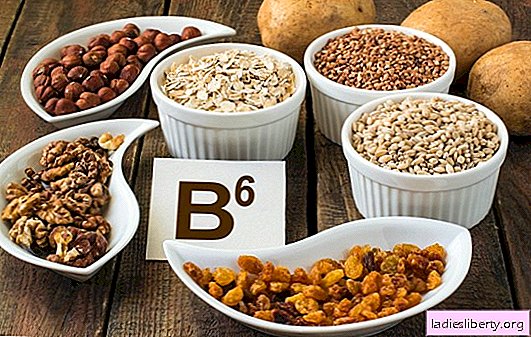
Water-soluble vitamin B6, also known as pyridoxal, adermin and pyridoxine, does not accumulate in the body, and therefore must constantly come from the outside.
The easiest and healthiest way is to get it daily with food, and not swallow a pharmacy synthesized drug. Knowing which foods contain vitamin B6, you can timely adjust your menu.
Useful properties of pyridoxine
Pyridoxine is involved in the production of antibodies for the immune system, which means protects the body from viral attacks and infections. This substance enriches nerve cells with glucose, removes carbohydrates from the liver and muscle tissue. The lack of vitamin B6 prevents the normal functioning of amino acids - the most important substance for the human body.
Pyridoxine is absorbed very easily, and with an excess, it is simply excreted in the urine. With magnesium deficiency, the absorption of vitamin B6 is difficult, therefore, ideally, you need to monitor the uniform intake of this trace element in the body. It is no coincidence that combination drugs, for example, MagneV6, are sold in pharmacies.
Why does man need pyridoxine? Here is a list of its main useful properties.
• Participates in metabolic processes, helps to extract energy from proteins, fats and carbohydrates that enter the body with food.
• Responds to optimal functioning of the nervous system, reduces depressive and aggressive manifestations. Taking the drug helps relieve numbness in the hands and cramps.
• Participating in the synthesis of nucleic acids, strengthens the immune defense and prevents premature aging.
• Normalizes the production of hormones and hemoglobin, is actively involved in the synthesis of enzymes, without which the human body can not work.
• Improves the absorption of fatty acids, which are very beneficial for health.
• Thins blood, preventing pathologies of the cardiovascular system.
Normal intake of vitamin B6 reduces the risk of developing age-related hypertension, and also prevents strokes, heart attacks, atherosclerosis. By eating foods that contain vitamin B6, we protect our health.
When does the body need vitamin B6?
There are situations when a person needs to get the norm of pyridoxine every day. The body is able to reproduce this vitamin on its own thanks to the microflora of the gastrointestinal tract. But its quantity is too small to make up for the need for this substance and to ensure the normal course of biochemical processes.
In normal situations, the amount of pyridoxine equal to two milligrams per day is considered normal. But sometimes this is not enough. Here are situations when a person needs more pyridoxine:
• he is professional in sports or is constantly experiencing great physical exertion;
• For a long time forced to stay in a cold room or work in the cold;
• experiencing constant mental stress, increased emotional stress;
• works with hazardous substances: poisons, toxic and radioactive elements;
• Eating too much protein food.
Future mothers and lactating women also need more vitamin B6, which is associated with an increased consumption of nutrients during these periods. It’s especially important for women to understand what foods contain vitamin B6 and eat healthy, natural foods every day.
How Vitamin B6 Deficiency Affects Health
If a person does not eat properly, does not receive the substances necessary for biochemical processes, the body very quickly begins to experience a lack of vitamins. This is manifested in appearance, affects well-being. The following symptoms appear:
• pathological conditions of the nervous system, manifested by outbreaks of anger, irritability, drowsiness, lethargy;
• nausea, decreased appetite;
• the occurrence of painful wounds, cracks in the corners of the lips;
• skin changes in the forehead, neck, eyelids, eyebrows, on the head under the hair: it becomes rough, uneven;
• Vertical cracks may appear in the center of the lower lip, although the skin may crack anywhere on the upper and lower lips.
Young children react violently to pyridoxine deficiency. They disrupt the work of the stomach and intestines, there is a delay in development and growth, convulsions may appear. Toddlers become overly excitable, often acting up.
If the pregnant woman’s food does not contain vitamin B6 in the required amount, then, along with irritability and insomnia, the expectant mother suffers from nausea, dermatitis, painful inflammation of the oral mucosa and tongue.
The physiological condition in which vitamin B6 deficiency may develop is acute diarrhea, other intestinal ailments, as well as acute and chronic inflammation of the liver. Deficiency can trigger some medications.
What foods contain vitamin B6
The task of corrective nutrition is to make up for the deficiency of pyridoxine in the body, and in the future to maintain its level within normal limits. By compiling a list of foods that contain vitamin B6, you can easily plan a menu for a week or a month.
Most beneficial substance in pine nuts. One hundred gram handful contains 0.094 mg (approximately 5% of the daily intake). A lot of pyridoxine in walnuts (0.8 mg), raw hazelnuts (0.7 mg).
A fish is an excellent source of pyridoxine. When we say which foods contain vitamin B6, we must first recall such species as:
• carcass of fresh tuna or in its own juice (0.8 mg);
• sardinella and sardine (0.7 mg);
• salmon, mackerel, salmon (0.8 mg);
• pink salmon (0.6 mg);
• herring (0.4 mg).
High fiber foods, including berries, can also be an excellent provider of vitamin B6. Record amount of pyridoxine contained in wheat germ (1.3 mg). What else you need to include in your diet:
• beans (0.9 mg);
• soybeans (0.85 mg);
• sea buckthorn berries (0.8 mg);
• horseradish root (0.7 mg);
• fresh garlic (0.6 mg);
• bell pepper (0.5 mg);
• pomegranate seeds (0.5 mg);
• ripe banana (0, 38 mg);
• potatoes (0.3 mg);
• grains of fresh corn (0.5 mg).
Be sure to include in the menu cereals. They help to lose weight, including due to the presence of pyridoxine in cereals. The maximum amount of B6 is in millet (0.6 mg). Slightly less in a cell (0, 54 mg), buckwheat (0.4 mg), oatmeal (0.27 mg). You can eat crackers (0.5 mg) and rye bread (0.2 mg).
From meat products include in the diet:
• chicken liver (0.9 mg);
• beef liver (0.7 mg);
• chicken (0.5 mg);
• beef kidneys (0.5 mg);
• pork (0.5 mg);
• rabbit meat (0.48 mg);
• beef (0.42 mg);
• lamb (0.3 mg);
• turkey (0.33 mg).
In other products familiar to us, which for many families are the basis and are constantly present on the table, the amount of B6 is insignificant. This, for example, chicken egg (0.14 mg), all types of cheese (0.1 mg), natural whole milk (0.05 mg).
So, what foods contain vitamin B6, found out. It remains to understand how to get it. The problem is that when the food is heated, any vitamins in them simply disappear, disintegrate. It is clear that no one will eat cereals, meat, fish, raw. How to be To preserve most of the nutrients, you need to cook food if possible by baking or boiling in steam, and not in water. Long stewing is undesirable, conventional cooking too.
Correctly compiling a diet, you will maintain health, vitality and youth for a long time. Eat healthy foods with natural vitamins every day and remember that pyridoxine is very healthy.











